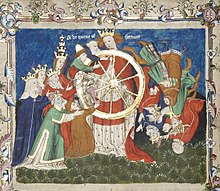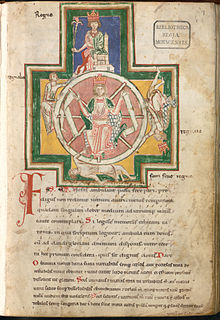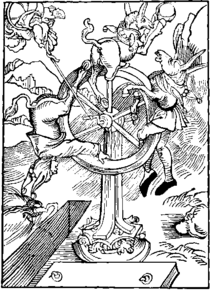The Wheels of Fate Begin Once Again

In medieval and aboriginal philosophy the Wheel of Fortune, or Rota Fortunae , is a symbol of the capricious nature of Fate. The wheel belongs to the goddess Fortuna (Greek equivalent Tyche) who spins information technology at random, changing the positions of those on the wheel: some suffer nifty misfortune, others gain windfalls. The metaphor was already a cliché in ancient times, complained near past Tacitus, but was greatly popularized for the Middle Ages by its extended treatment in the Consolation of Philosophy by Boethius from around 520. It became a common image in manuscripts of the book, and so other media, where Fortuna, often blindfolded, turns a large wheel of the sort used in watermills, to which kings and other powerful figures are attached.
Origins [edit]

The origin of the word is from the "wheel of fortune"—the zodiac, referring to the Celestial spheres of which the 8th holds the stars, and the 9th is where the signs of the zodiac are placed. The concept was first invented in Babylon and later developed by the ancient Greeks.
The concept somewhat resembles the Bhavacakra, or Wheel of Becoming, depicted throughout Ancient Indian art and literature, except that the earliest conceptions in the Roman and Greek world involve not a ii-dimensional bike simply a three-dimensional sphere, a metaphor for the world. It was widely used in the Ptolemaic perception of the universe every bit the zodiac being a wheel with its "signs" constantly turning throughout the year and having effect on the globe's fate (or fortune).
In the second century BC, the Roman tragedian Pacuvius wrote:
Fortunam insanam esse et caecam et brutam perhibent philosophi,
Saxoque instare in globoso praedicant volubili:
Id quo saxum inpulerit fors, eo cadere Fortunam autumant.
Caecam ob eam rem esse iterant, quia nihil cernat, quo sese adplicet;
Insanam autem esse aiunt, quia atrox, incerta instabilisque sit down;
Brutam, quia dignum atque indignum nequeat internoscere.Philosophers say that Fortune is insane and blind and stupid,
and they teach that she stands on a rolling, spherical rock:
they assert that, wherever hazard pushes that rock, Fortuna falls in that management.
They echo that she is blind for this reason: that she does not see where she'southward heading;
they say she's insane, because she is cruel, flaky and unstable;
stupid, considering she tin't distinguish between the worthy and the unworthy.
—Pacuvius, Scaenicae Romanorum Poesis Fragmenta. Vol. one, ed. O. Ribbeck, 1897
The idea of the rolling brawl of fortune became a literary topos and was used frequently in declamation. In fact, the Rota Fortunae became a prime number example of a trite topos or meme for Tacitus, who mentions its rhetorical overuse in the Dialogus de oratoribus.

In the 2nd century Ad, astronomer and astrologer Vettius Valens wrote:
-
- In that location are many wheels, most moving from due west to east, but some move from east to w.
- Seven wheels, each hold i heavenly object, the showtime holds the moon...
- Then the eighth wheel holds all the stars that we come across...
-
- And the ninth wheel, the wheel of fortunes, moves from e to west,
- and includes each of the twelve signs of fortune, the twelve signs of the zodiac.
- Each cycle is inside the other, similar an onion's peel sits inside another peel, and there is no empty space between them.[ This quote needs a citation ]

Boethius [edit]
The goddess and her Wheel were eventually absorbed into Western medieval thought. The Roman philosopher Boethius (c. 480–524) played a key part,[4] utilizing both her and her Wheel in his Consolatio Philosophiae. For case, from the beginning chapter of the 2d book:
I know the manifold deceits of that monstrous lady, Fortune; in particular, her fawning friendship with those whom she intends to crook, until the moment when she unexpectedly abandons them, and leaves them reeling in agony beyond endurance.
[...]
Having entrusted yourself to Fortune's dominion, you lot must accommodate to your mistress's ways. What, are you trying to halt the motion of her whirling cycle? Dimmest of fools that you are, you lot must realize that if the cycle stops turning, it ceases to be the class of run a risk."[5]
In the middle ages [edit]

Religious teaching [edit]
The Wheel was widely used as an apologue in medieval literature and fine art to aid religious instruction. Though classically Fortune'southward Wheel could be favourable and disadvantageous, medieval writers preferred to concentrate on the tragic attribute, dwelling on downfall of the mighty – serving to remind people of the temporality of earthly things. In the morality play Lowest (c. 1495), for instance, Death comes unexpectedly to claim the protagonist. Fortune'due south Wheel has spun Everyman low, and Good Deeds, which he previously neglected, are needed to secure his passage to heaven.
Geoffrey Chaucer used the concept of the tragic Cycle of Fortune a great deal. Information technology forms the basis for the Monk's Tale, which recounts stories of the great brought low throughout history, including Lucifer, Adam, Samson, Hercules, Nebuchadnezzar, Belshazzar, Nero, Alexander the Swell, Julius Caesar and, in the following passage, Peter I of Cyprus.
- O noble Peter, Republic of cyprus' lord and king,
- Which Alexander won by mastery,
- To many a heathen ruin did'st g bring;
- For this thy lords had so much jealousy,
- That, for no crime relieve thy high chivalry,
- All in thy bed they slew thee on a morrow.
- And thus does Fortune'due south wheel plough treacherously
- And out of happiness bring men to sorrow.
~ Geoffrey Chaucer, The Canterbury Tales, The Monk's Tale[6]
Fortune'due south Cycle ofttimes turns up in medieval art, from manuscripts to the great Rose windows in many medieval cathedrals, which are based on the Bicycle. Characteristically, it has 4 shelves, or stages of life, with iv human figures, usually labeled on the left regnabo (I shall reign), on the top regno (I reign) and is usually crowned, descending on the right regnavi (I have reigned) and the lowly figure on the bottom is marked sum sine regno (I am without a kingdom). Dante employed the Cycle in the Inferno and a "Wheel of Fortune" trump-card appeared in the Tarot deck (circa 1440, Italy).
Political teaching [edit]

The bicycle of fortune from the Burana Codex; The figures are labelled "Regno, Regnavi, Sum sine regno, Regnabo": I reign, I reigned, I take no kingdom, I shall reign
In the medieval and renaissance period, a popular genre of writing was "Mirrors for Princes", which gear up out advice for the ruling classes on how to wield power (the virtually famous being The Prince by Niccolò Machiavelli). Such political treatises could use the concept of the Wheel of Fortune as an instructive guide to their readers. John Lydgate's Fall of Princes, written for his patron Humphrey, Duke of Gloucester is a noteworthy example.
Many Arthurian romances of the era also use the concept of the Bicycle in this manner, often placing the Nine Worthies on it at various points.
...fortune is and so variant, and the wheel and then moveable, there nis none constant abiding, and that may be proved past many old chronicles, of noble Hector, and Troilus, and Alisander, the mighty conquistador, and many mo other; when they were most in their royalty, they alighted lowest. ~ Lancelot in Thomas Malory'southward Le Morte d'Arthur, Chapter XVII.[7]
Like the Mirrors for Princes, this could be used to convey advice to readers. For case, in most romances, Arthur's greatest military achievement – the conquest of the Roman Empire – is placed tardily on in the overall story. However, in Malory'south work the Roman conquest and high betoken of King Arthur's reign is established very early on. Thus, everything that follows is something of a pass up. Arthur, Lancelot and the other Knights of the Round Tabular array are meant to be the paragons of chivalry, yet in Malory'due south telling of the story they are doomed to failure. In medieval thinking, only God was perfect, and fifty-fifty a great figure like King Arthur had to be brought low. For the noble reader of the tale in the Centre Ages, this moral could serve as a warning, only also every bit something to aspire to. Malory could exist using the concept of Fortune'due south Cycle to imply that if even the greatest of chivalric knights fabricated mistakes, then a normal fifteenth-century noble didn't have to exist a paragon of virtue in order to exist a good knight.
Carmina Burana [edit]
The Bicycle of Fortune motif appears significantly in the Carmina Burana (or Burana Codex), albeit with a postclassical phonetic spelling of the genitive form Fortunae. Excerpts from two of the drove'due south meliorate known poems, "Fortuna Imperatrix Mundi (Fortune, Empress of the World)" and "Fortune Plango Vulnera (I Bewail the Wounds of Fortune)," read:
|
|
Later usage [edit]
Fortune and her Wheel accept remained an indelible image throughout history. Fortune'southward wheel tin can as well be establish in Thomas More'southward Utopia.
Shakespeare [edit]

William Shakespeare in Hamlet wrote of the "slings and arrows of outrageous fortune" and, of fortune personified, to "pause all the spokes and fellies from her wheel." And in Henry Five, Act iii Scene VI[eight] are the lines:
- Pistol:
- Bardolph, a soldier business firm and sound of centre
- And of buxom valor, hath by vicious fate
- And light-headed Fortune's furious fickle bicycle
- That goddess blind,
- That stands upon the rolling restless rock—
- Fluellen:
- Past your patience, Aunchient Pistol. Fortune is painted blind, with a muffler afore his eyes, to signify to you that Fortune is blind; and she is painted also with a bicycle, to signify to yous, which is the moral of information technology, that she is turning, and inconstant, and mutability, and variation. And her foot, await you lot, is fixed upon a spherical stone, which rolls, and rolls, and rolls.
- Pistol:
- Fortune is Bardolph's foe, and frowns on him;
Shakespeare likewise references this Wheel in King Lear. The Earl of Kent, who was one time held dear by the King, has been banished, only to return in disguise. This bearded character is placed in the stocks for an overnight and laments this turn of events at the end of Act II, Scene 2:[9]
- Fortune, good dark, smiling once more than; turn thy cycle!
In Human action Four, scene seven, King Lear as well contrasts his misery on the "bike of fire" to Cordelia's "soul in bliss".
Rosalind and Celia as well talk over Fortune, especially as it stands opposed to Nature, in Every bit Y'all Similar It, Act I, scene ii.
Victorian era [edit]
In Anthony Trollope'due south novel The Manner We Live At present, the character Lady Carbury writes a novel entitled The Wheel of Fortune about a heroine who suffers great financial hardships.
Modernistic day [edit]
Selections from the Carmina Burana, including the 2 poems quoted higher up, were fix to new music by twentieth-century classical composer Carl Orff, whose well-known "O Fortuna" is based on the poem Fortuna Imperatrix Mundi.
Literature [edit]
Fortuna does occasionally turn up in modern literature, although these days she has go more or less synonymous with Lady Luck. Her Wheel is less widely used as a symbol, and has been replaced largely by a reputation for fickleness. She is frequently associated with gamblers, and dice could likewise be said to have replaced the Cycle as the main metaphor for uncertain fortune. In his novel, The Club Dumas, Arturo Pérez-Reverte includes a wheel of fortune in one of the illustrations that accompany the text. Ignatius J. Reilly, the primal protagonist of John Kennedy Toole's novel A Confederacy of Dunces, states that he believes the Rota Fortunae to be the source of all men'south fate.
Pop music [edit]
Jerry Garcia recorded a vocal entitled "The Wheel" (co-written with Robert Hunter and Bill Kreutzmann) for his 1972 solo album Garcia, and performed the vocal regularly with the Grateful Dead from 1976 onward. The song "Wheel in the Sky" past Journey from their 1978 release Infinity besides touches on the concept through the lyrics "Bicycle in the sky keeps on turnin' / I don't know where I'll exist tomorrow". The song "Throw Your Hatred Downwardly" by Neil Young on his 1995 album Mirror Ball, recorded with Pearl Jam, has the poetry "The cycle of fortune / Keeps on rollin' down". The Trip-Hop group Massive Attack refer to the Wheel of Fortune on their track "Hymn Of The Big Wheel" on the 1991 album Blue Lines.
Folk music [edit]
Several old folk tunes mention the wheel of fortune, virtually notably 'Fakenham Fair' with its chorus lyrics of 'So spin me around on the merry-become-circular/Give the wheel of fortune a whirl'.
Film and idiot box [edit]
Various games of chance involve spinning a wheel marked with preset outcomes, mirroring the "bike of fortune" concept. This is notably done on the long-running, internationally syndicated game show Bicycle of Fortune, where contestants win or lose money adamant by the spin of the bike. Such a wheel is also featured in the game show The Price Is Right, in the "Showcase Showdown" segment. In the 1985 film Mad Max Across Thunderdome, such a bike was used to make up one's mind punishments for criminals.
The 1994 moving-picture show The Hudsucker Proxy refers often to the Rota Fortunae concept, especially in its utilise of circles as a visual motif. In the Tv serial Firefly (2002), the chief graphic symbol, Malcolm Reynolds, says "The Bicycle never stops turning, Annoy" to which Badger replies "That only matters to the people on the rim". In the science fiction Television series Farscape, the third-flavour episode "Self-Inflicted Wounds (Office two): Wait for the Wheel" has main character Crichton mention that his grandmother told him that fate was similar a cycle, alternately bringing fortunes upwards and down.
In the episode The Bitter Suite of the 1995 television set bear witness Xena: Warrior Princess, Xena spins the wheel of fortune at the offset of her journey through Illusia, a mystical land where the main characters Xena and Gabrielle will ultimately have to face both their pasts and their relationship in its current state. Later in the episode a rope of flame appears and starts to drag Gabrielle though the Fortune Wheel, so drags Xena along as well.
Games [edit]
The video game series grapheme Kain (Legacy of Kain) used the bike of fate. In theFable video game series, the wheel of fortune appears twice, somehow perverted. The Wheel of Unholy Misfortune is a torture device inFable Two. It is plant in the Temple of Shadows in Rookridge. The Hero can utilize the bicycle to sacrifice followers to the shadows. InLegend III, Reaver'southward Wheel of Misfortune is a device that, once activated, sends to The Hero a round of random monsters.
The Wheel of Fortune is featured in a Magic: The Gathering card past that proper noun that forces all players to discard their hands and draw new ones.
References [edit]
- ^ "statuette of Fortuna". Hunterian Museum & Fine art Gallery Collections: GLAHM F.43. Academy of Glasgow. Retrieved 13 October 2017.
- ^ "Roman statuette of Fortuna". BBC - A History of the World . Retrieved 12 October 2017.
- ^ MacDonald, James (1897). Tituli Hunteriani: An Account of the Roman Stones in the Hunterian Museum, University of Glasgow. Glasgow: T. & R. Annan & Sons. pp. 90–91. Retrieved 11 October 2017.
- ^ Patch, Howard Rollin (1927). The Goddess Fortuna in Medieval Literature. Cambridge: Harvard University Printing. ISBN9780674183780.
- ^ Boethius (2008). The Consolation of Philosophy. Oxford: Oxford University Press. pp. 19–20. ISBN978-0-19-954054-nine.
- ^ "The Monk's Tale, Modern English language – Canterbury Tales – Geoffrey Chaucer (1340?–1400)". Classiclit.about.com. 2009-11-02. Retrieved 2011-11-24 .
- ^ "Le Morte d' Arthur – Chapter XVII". Worldwideschool.org. Archived from the original on 2016-04-11. Retrieved 2011-11-24 .
- ^ "Rex Henry V by William Shakespeare: Deed three. Scene Half dozen". Online-literature.com. 2007-01-26. Retrieved 2011-11-24 .
- ^ "Act II. Scene II. King Lear. Craig, W.J., ed. 1914. The Oxford Shakespeare". Bartleby.com. Retrieved 2011-11-24 .
Source: https://en.wikipedia.org/wiki/Rota_Fortunae
0 Response to "The Wheels of Fate Begin Once Again"
Enregistrer un commentaire